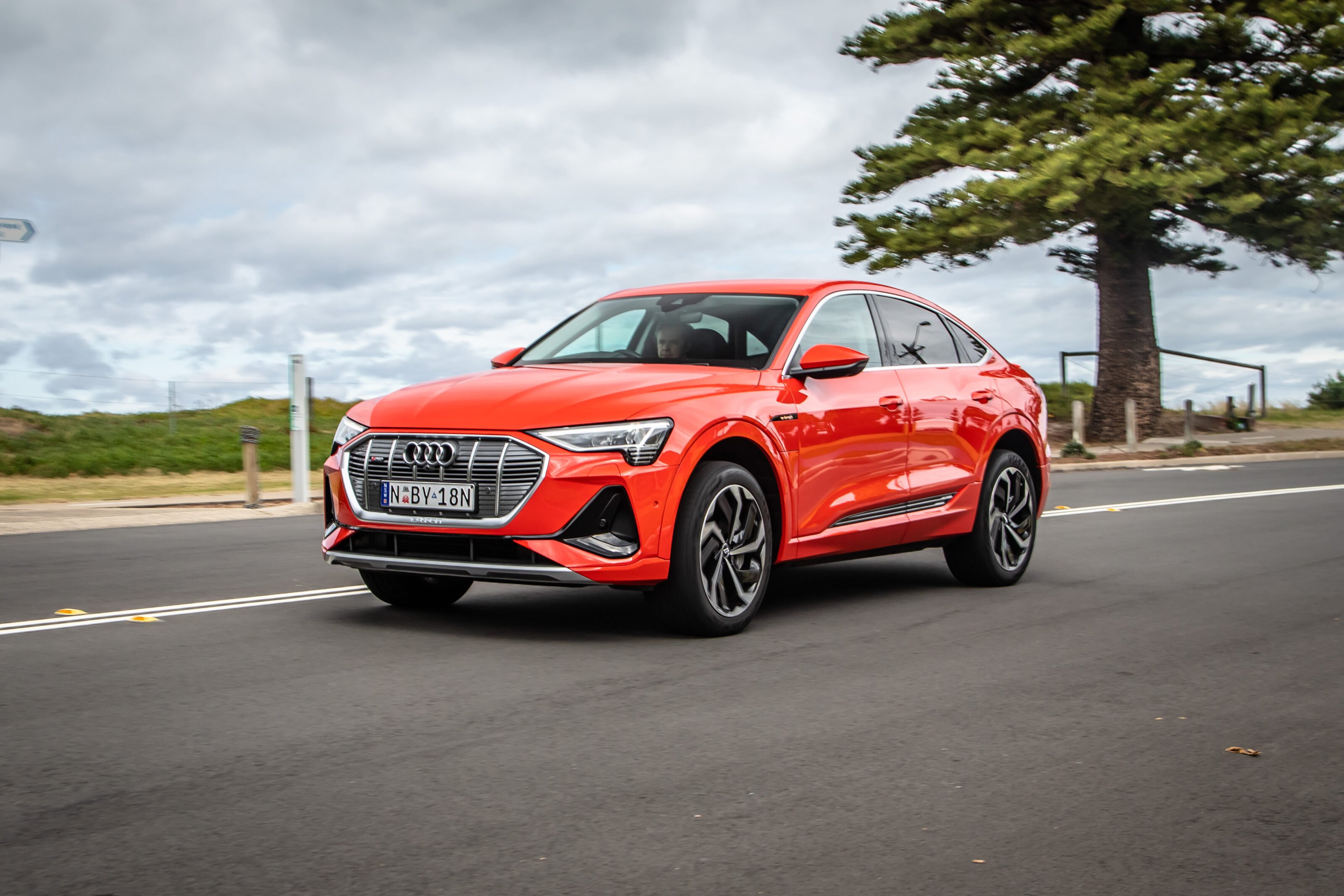Score breakdown
Things we like
- Powerful
- Classy looks, terrific interior
- Easy to live with
Not so much
- Pricey
- MLB-based so a bit compromised
- Feels as heavy as it is
If you’re a carmaker in the EU, you have to show everyone you’ve got your ducks in a row. For all its many years of making electric concepts and limited run stuff like the R8 E-Tron, Audi’s first customer battery-electric vehicle was a long time coming. And when it arrived, it arrived in a form that our car market could recognise – an SUV. Not a weird city car made of carbonfibre or a dull, humdrum hatchback but a big, five-seater luxury SUV.
The Audi E-Tron has been around since 2019 and, here in Australia, for around a year.
It hasn’t exactly gone bananas in the sales, but that has something to do with the fact that it’s a gap plugger until things really start to get going, like the Q4 E-Tron that we hope to see soon. And at less than a hundred grand, if the winds blow the right way.
With competitors coming thick and fast – BMW and Mercedes are building up quite an onslaught – another look at the E-Tron is in order to remind ourselves of Ingolstadt’s first attempt and how it’s standing up to the scrutiny.
Pricing and Features
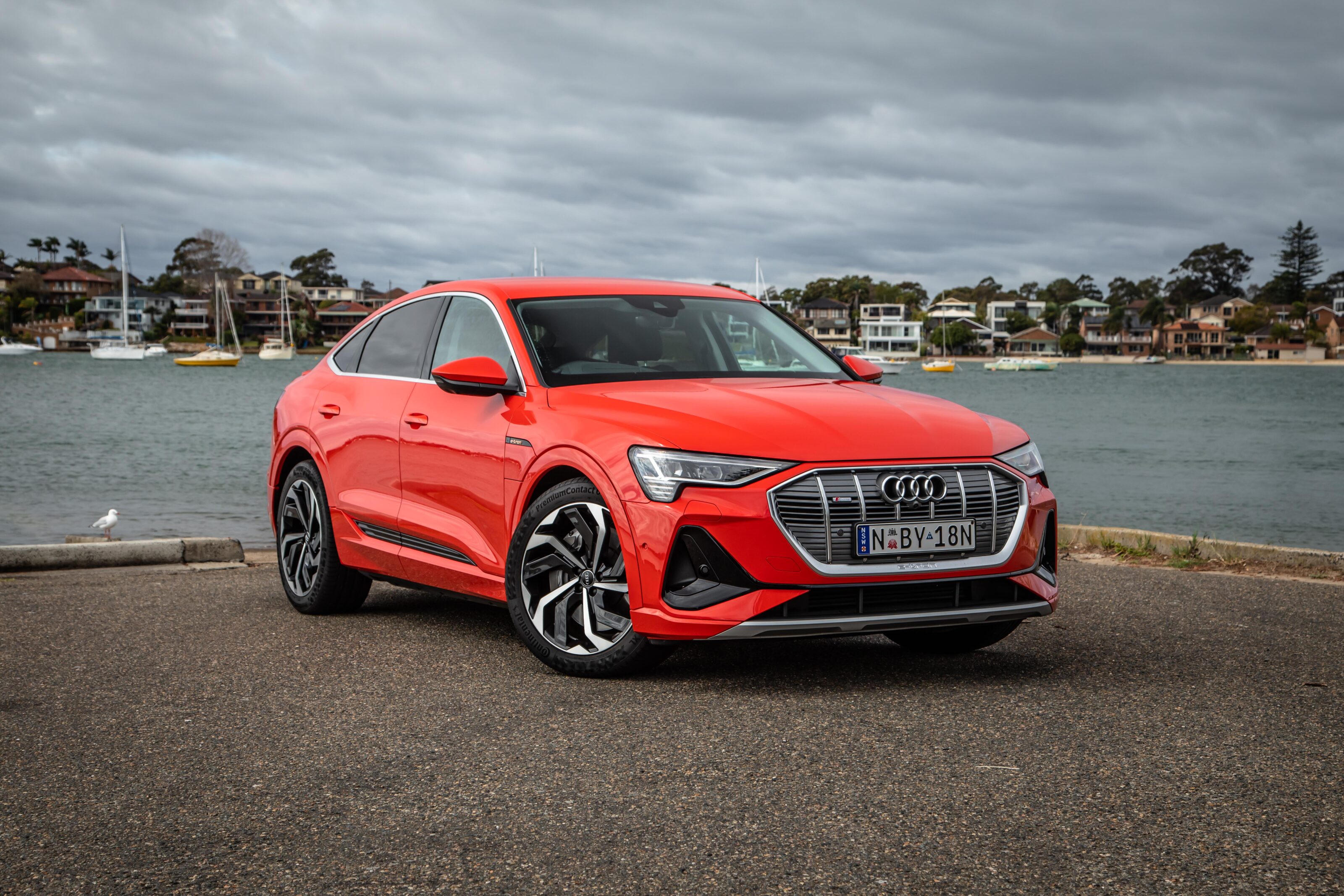
Without putting too fine a point on it, the E-Tron 50 Sportback is a lot of money at $148,100 before on-roads. With the BMW iX starting well below that and a new version of the EQC to undercut it, as well as all but the top-spec Jaguar i-Pace costing less, it had better come out swinging with the stuff.
And it does.
The E-Tron rolls out of the factory on 21-inch alloy wheels and the Catalunya red of the test car was an option costing $2300. Standard is a Milano leather interior, multi-zone climate control, 10-speaker stereo, wireless charging pad, head-up display, powered tailgate, heated sports front seats, electric folding and heated rear vision mirrors, adaptive cruise, auto LED headlights, around-view cameras, reversing camera, keyless entry and start, inbuilt sat-nav, auto wipers and a space-saver spare tyre.

Audi’s S-Line exterior package is also standard, with beefier front and rear bumpers plus a grille badge and brake calipers with orange E-Tron inscription.
The two touchscreens are 10.1-inches for the MMI screen and 8.6-inches for the lower screen (the instrument pack is Audi’s 12.3-inch Virtual Cockpit). You get all the Audi Connect Plus goodness and you can do things with a phone app like unlock the doors, turn on the climate control, that kind of thing.
The MMI screen features some visuals to help you understand where the power is flowing and how, but it somehow misses out on some really nerdy stuff, as does the dashboard. You also get DAB+ digital radio into the bargain.
Without putting too fine a point on it, the E-Tron 50 Sportback is a lot of money at $148,100 before on-roads and options.
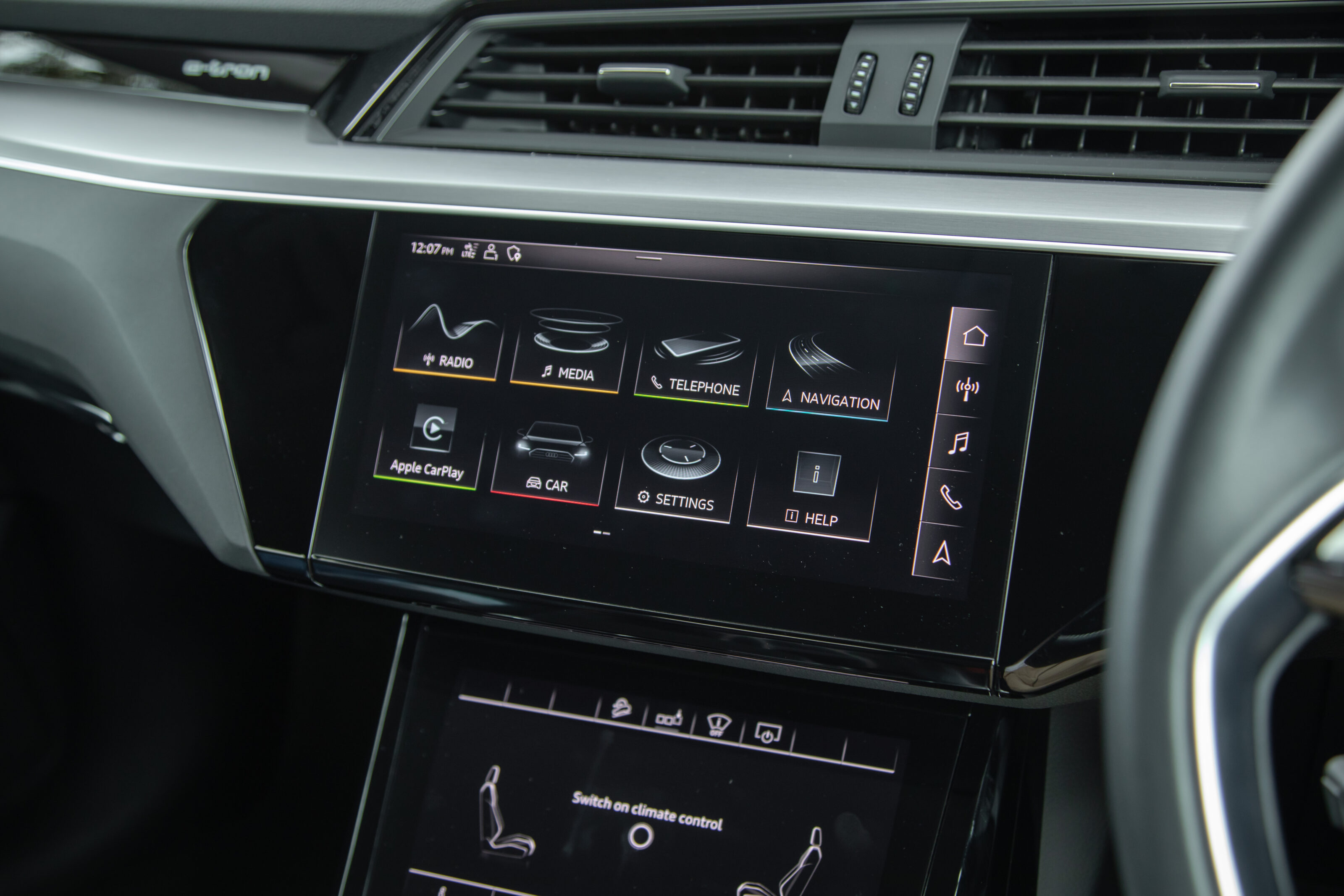
The safety package is comprehensive, with six airbags, ABS and stability controls, forward collision warning, forward AEB, rear cross-traffic alert, forward cross-traffic alert, exit warning, blind-spot monitoring, lane-keep assist, collision avoidance assist (with steering help) and Audi’s pre-sense tech, which pulls the seatbelts tight and closes the windows if it thinks things are about to get percussive.
Babies’ and kids’ seats are looked after with three top-tether anchors and two ISOFIX points.
On arrival in 2019, the E-Tron scored five ANCAP safety stars.
Comfort and Space

Weirdly, the E-Tron is not built on VAG’s MEB dedicated electric platform but on the long-established MLB platform under which you’ll find every large SUV from VW to Lamborghini and every Audi from the A4 and up. As a result, it’s a little compromised and doesn’t have that familiar skateboard vibe of rival EVs like the i-Pace.
Available in SUV and coupe-like Sportback bodystyles, the latter loses nothing obvious from its occupant space and suffers just a little drop in cargo space from 660 litres in the SUV to 615 litres.
The froot box is the same 60 litres and is really just there for the portable charger. If you put the seats down there’s probably well over 1500 litres, but Audi doesn’t supply a figure for that.
The E-Tron feels Q7-wide because, well, it is, but that means the cabin has plenty of space and light. Front-row occupants are mollycoddled in big comfortable seats. There are two cup holders, a small cube of storage space under the armrest and bottle holders in the doors.
The cup holders have a slot between them for standing your phone vertically and next to it is the clever charging pad. You lie your phone on its side and slide it into a spring-loaded clip to keep it against the pad and also not flying about when you go around a corner. A little bit like Hyundai’s in the Santa Fe/Palisade, in fact.

The E-Tron also has the familiar dual-screen setup from Q7 and Q8, with the big 10.1-inch screen for car and media functions while the lower one looks after climate controls and secondary functions.
The dash design is similar to the Q7 and Q8, with excellent full-width air vents and lovely detailing. I remain very attached to the gear selector, which looks like the throttle control from a sci-fi fighter ship.
Rear-seat passengers have a nearly flat floor, so three across the back is probably fine although the centre console intrudes into what would be knee or shin space.
Given its size, the head and legroom is plentiful and the falling Sportback roofline doesn’t interfere with your cranium. Unless you’re not paying attention when you’re getting out.
If you’re regularly hauling kids or capsules out of the back seat, the SUV might be a better bet to keep your head in the same shape as when you started.
On the Road
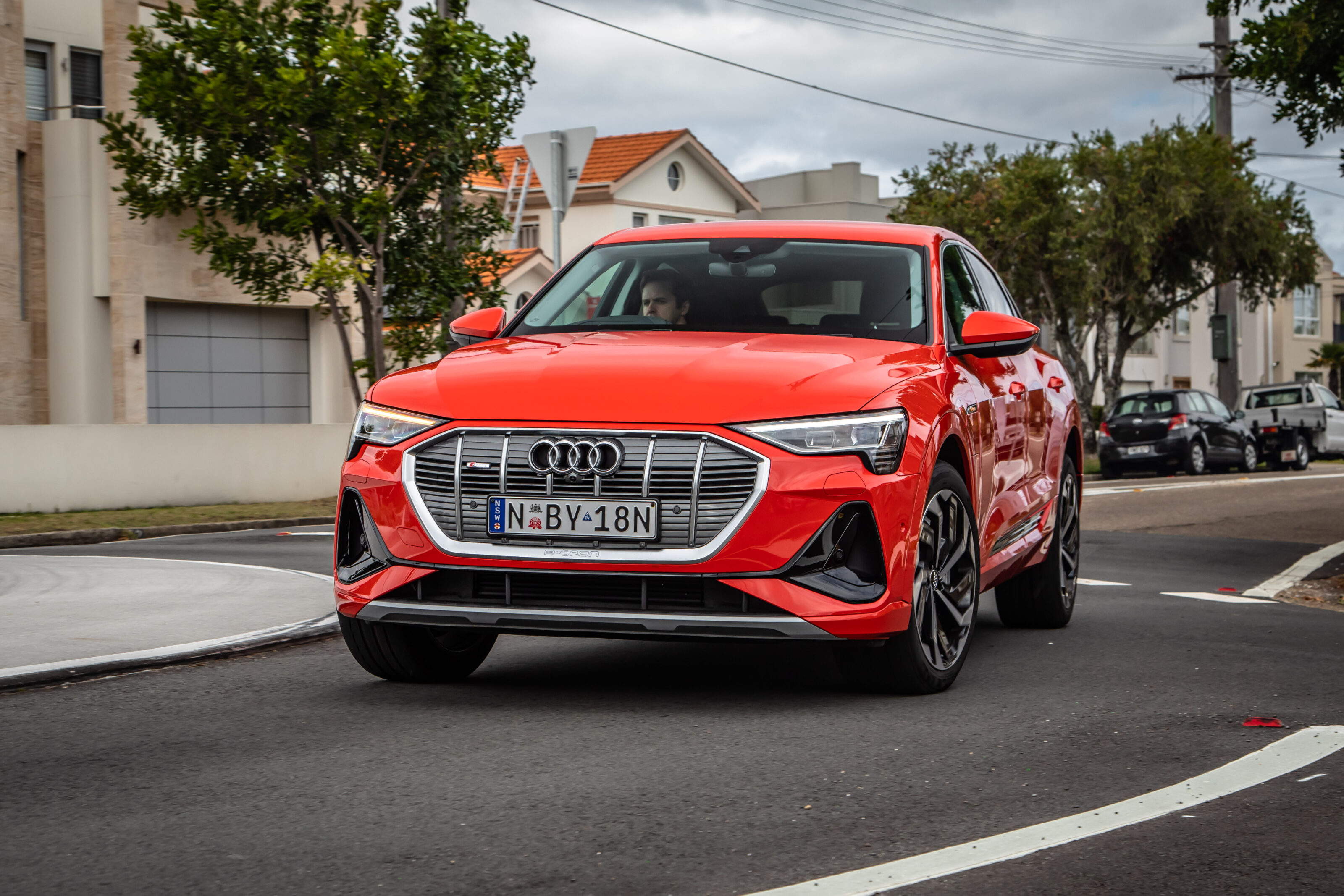
With the E-Tron, you have a choice of two power levels, the 50 and 55. The 50 has a 71kWh battery (64kWh useable) for a WLTP range of more than 300km while the 55 sports a bigger, 95kWh battery for a WLTP range in excess of 400km.
You can charge at home from a domestic socket or an optional 11kW AC charging kit from JETCharge. The 50 offers up to 120kW fast-charging and the 55 has 150kW fast-charging support.
The 50 as tested here has a total of 230kW and 540Nm driving all four wheels (of course) and will cover the sprint to 100km/h in 6.8 seconds, which is not bad at all. If you step up to the 55, you get 300kW and 664Nm for a 5.7-second run to the ton.
You can also tow 1800kg if you fancy making fun of a government minister in your spare time.
The 50 has 230kW and 540Nm driving all four wheels and will sprint to 100km/h in 6.8 seconds, which is not bad at all. You can also tow 1800kg if you fancy making fun of a government minister in your spare time.

Unfortunately, the overwhelming feeling of the E-Tron, at least initially, is that it’s big and heavy. And it is, well over two tonnes, which is partly down to the MLB platform but mostly due to batteries. As always, though, the weight is lower down than an ICE car, so that certainly has its benefits.
Added to that, the air suspension does its best to further reduce the feeling of weight, to the point where it’s almost banished in Dynamic mode. It always feels big but, as I say, that’s because it is.
It does feel quick, though. I’ve driven quite a few EVs and I still can’t quite reconcile their near-silent acceleration, with just a couple of clicks and whirrs once the system realises you mean business.
The throttle is lively unless you’re in Efficiency mode (hint: not even once) and it’s easy to modulate your speed once you get used to the way it all works. Unlike some EVs, the brake feel is good and there isn’t an awkward switch between recovery braking and actual braking.
I did often wish for a more aggressive recovery system, though. The paddleshifters are good for that “here I am downshifting for the corner feel” but I’d prefer the one-pedal operation of, say, a BMW i3 or Nissan Leaf. Yes, neither of those are anything like this car, no I haven’t driven a Tesla recently so can’t compare it.
And once you’ve completed the corner, the paddle-shifting is for naught because it goes back to the more relaxed default setting. Perhaps there is a way to make it more aggressive permanently and if there is, it’s well buried.
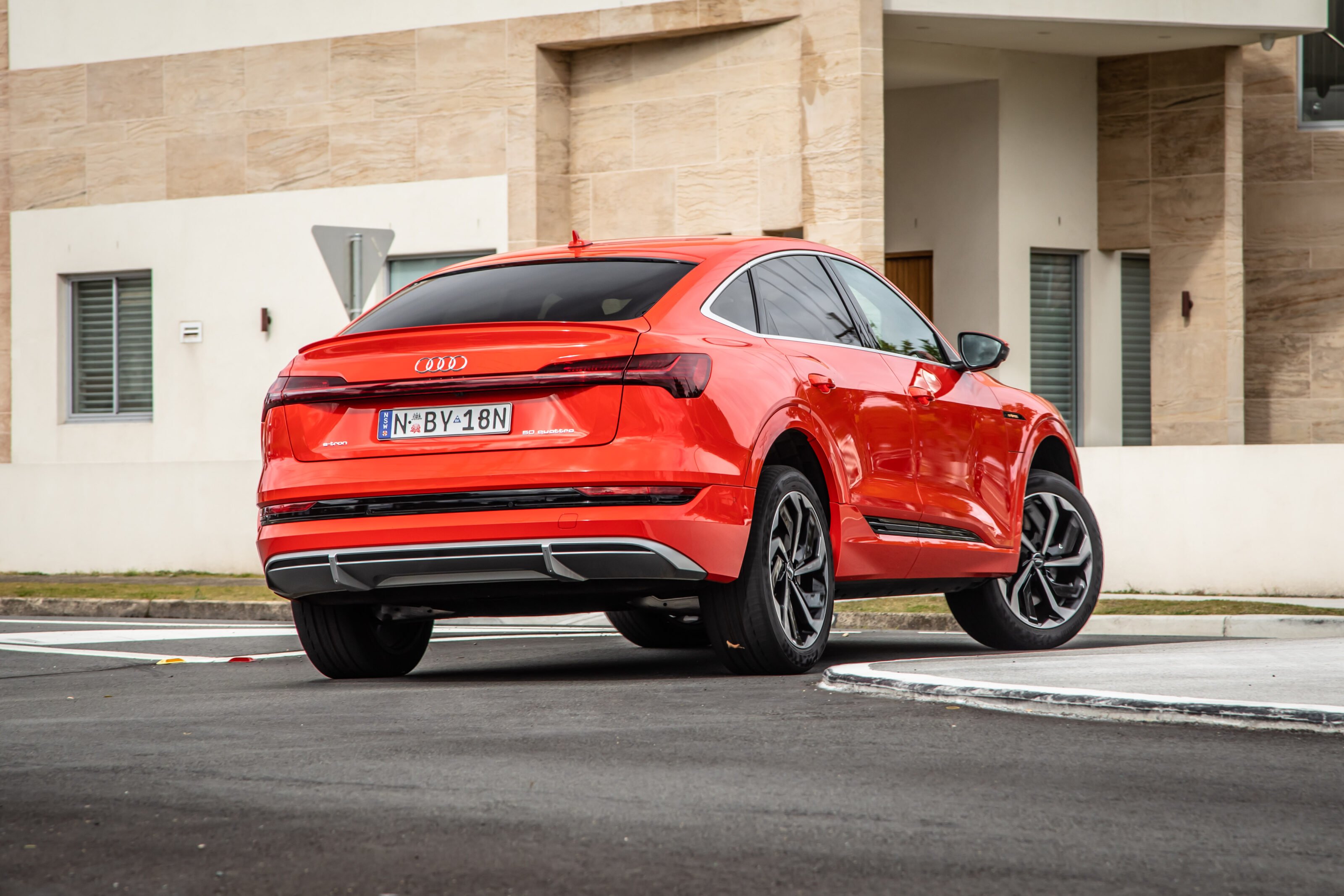
My time with the E-Tron was sadly restricted to shorter runs than I might have liked. As a result, its power consumption was a substantial 29.7kWh/100km, which means I’d just squeak out 300km, but you don’t want to be squeaking in an EV, especially in my part of Sydney which is a black hole for public charging.
The supplied six-year Chargefox subscription would be rather handier if I lived in another part of Sydney, specifically the bits between the northern shores of Botany Bay and the lower North Shore. The options in Melbourne, Brisbane and the Gold Coast are more favourable no matter where you live in the metro area and even Perth seems relatively well-served. Adelaide less so.
Luckily, when you’re not covering a lot of miles you don’t have to charge very often and when you do, home charging is extremely useful and more to the point, perfectly adequate.
I – and I imagine a number of owners – have the choice of charging for free during the day from our rooftop solar or looking up when the exorbitant time-of-day rates in Sydney drop from the utterly outrageous 50-odd cents per kilowatt-hour to 13c/kWh (10pm, as it turns out) and set the car up to start charging then.
It’s real set-and-forget stuff and there’s always the small joy of pressing the button on the charge port and the little door opening electrically. There are two charge ports, one on either side of the car, but only one side is a DC port.
Ownership
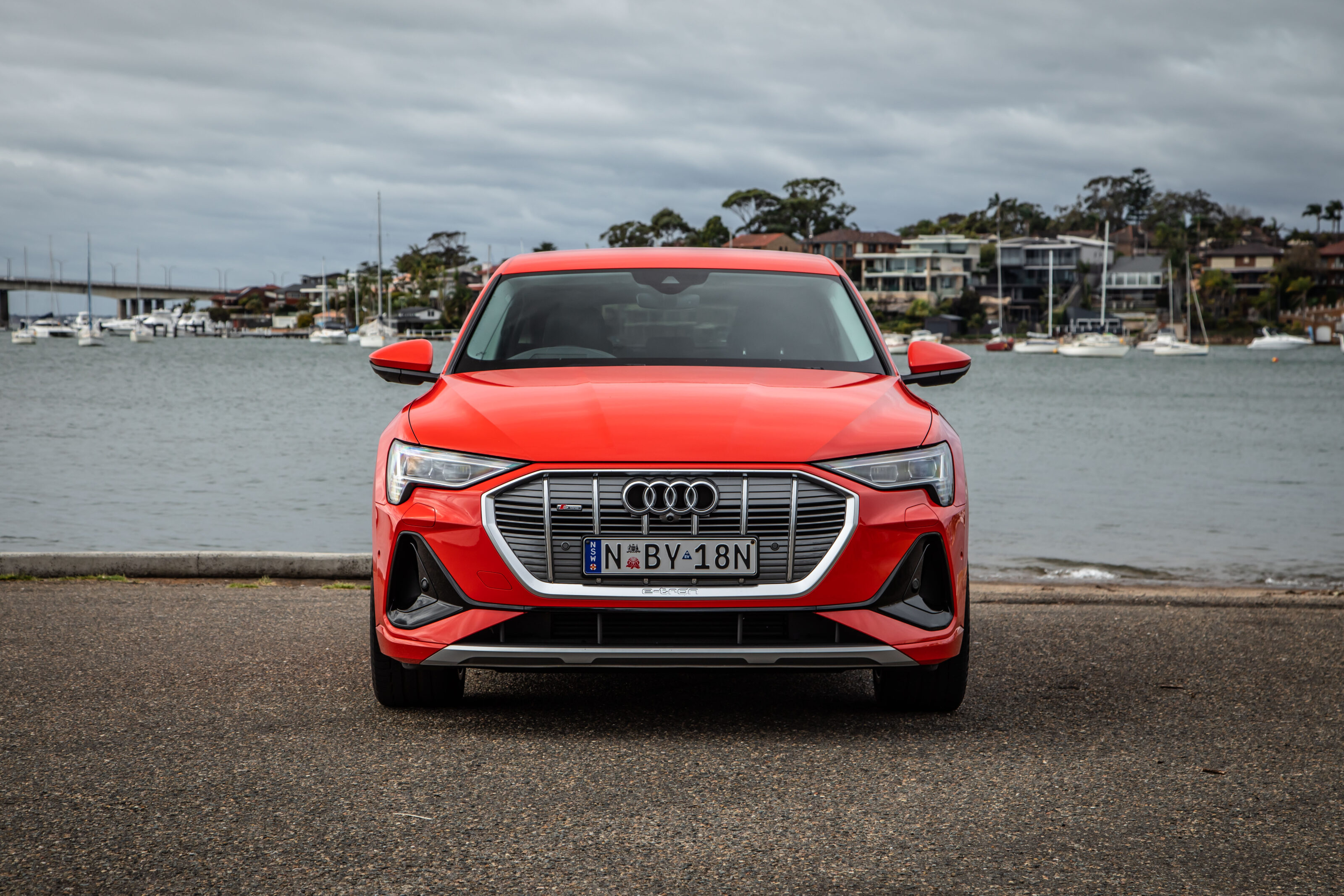
Yep, it’s still a three year/unlimited-kilometre warranty at Audi, which remains frustrating given Mercedes has stepped it up to five years but I’m also looking at you, BMW. There is an eight year/160,000km warranty for the battery, however.
Audi one-ups just about every other EV offering on the market with a six-year subscription to public charging network Chargefox.
Chargefox has 770 locations, without about 10 per cent of them proper fast-charging points of more than 120kW.
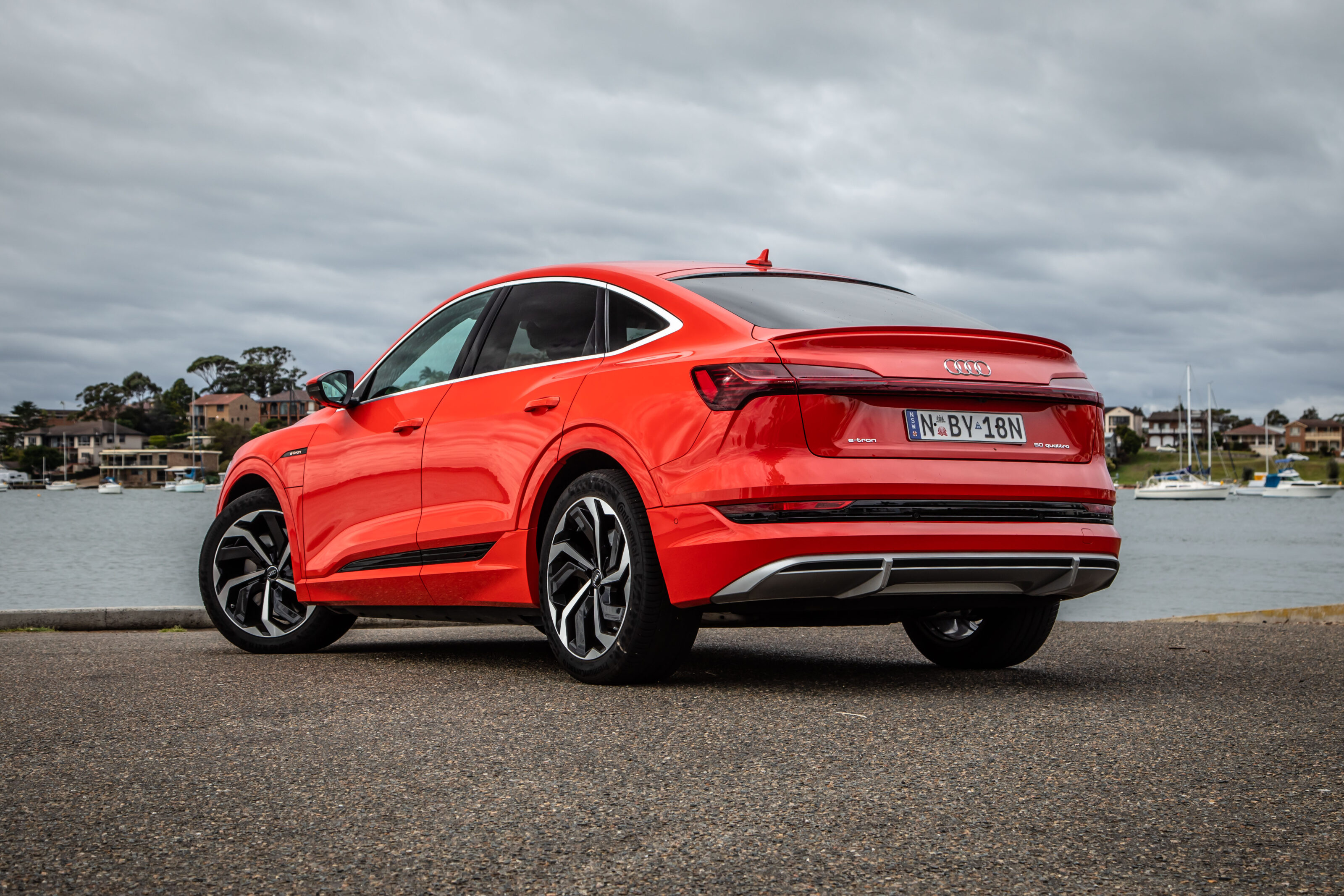
VERDICT
The E-Tron might be the sort of cutting edge technology we’ve come to expect of EVs but there’s a very real sense that Audi made sure not to make it too oddball or too in-yer-face EV. It’s almost like there were more wacky proposals on the table but everyone said, “What if we just made a car that’s electric that people might want to buy and isn’t intimidating for the EV-curious?” And that’s what we’ve got.
It’s very Audi – big wheels, Q-styling, terrific interior design and execution. It doesn’t have the numbers or rip-out-your-spleen acceleration of a Tesla, but nor does it have all that baggage. It drives like a normal car, except just plug it in when you get home.
While it is a little compromised for being built on MLB, that’s also a strength – Audi’s engineers and designers knew what they were doing from the get-go and what they had to work with. It hasn’t – and won’t – set the world on fire, but it has respawned the E-Tron brand as a full EV proposition while not being obnoxious about it.
| Body:u00a0 | Five-door SUV |
|---|---|
| Drive: | AWD |
| Engine: | Dual-motor electric |
| Transmission: | Single-speed |
| Power: | 230kW @ 0 rpm |
| Torque:u00a0 | 540Nm @ 0 rpm |
| Bore stroke (mm): | NA |
| Compression ratio:u00a0 | NA |
| 0-100km/h:u00a0 | 6.8sec (claimed) |
| Fuel consumption:u00a0 | 22.7kWh/100km (combined) |
| Weight: | 2612kg |
| Suspension: | MacPherson struts front/multi-link rear |
| L/W/H:u00a0 | 4901mm/1935mm/1616mm |
| Wheelbase: | 2928mm |
| Brakes:u00a0 | 399mm ventilated disc front / 351mm ventilaed disc rear |
| Tyres:u00a0 | 265/45 R21 |
| Wheels:u00a0 | 21-inch alloy wheels (space-saver spare) |
| Price:u00a0 | $141,800 + ORC |
Score breakdown
Things we like
- Powerful
- Classy looks, terrific interior
- Easy to live with
Not so much
- Pricey
- MLB-based so a bit compromised
- Feels as heavy as it is
We recommend
-
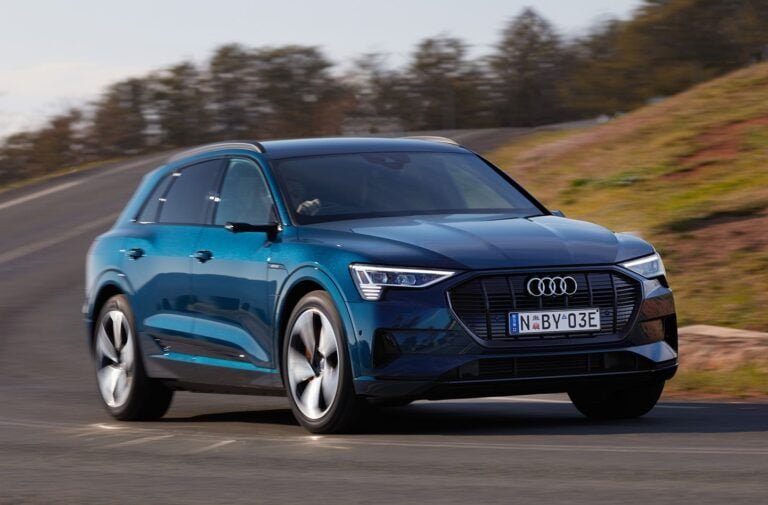 Reviews
Reviews2021 Audi E-Tron 55 quattro review
Audi's most powerful e-tron offers plenty of electric thrills, but that's not where it impresses most
-
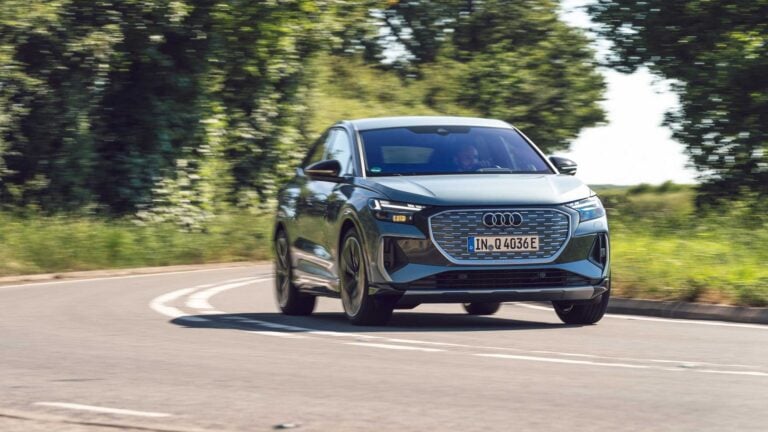 Reviews
ReviewsFirst drive: 2021 Audi Q4 Sportback E-Tron
It's billed as the mainstream offering of Audi's EV strategy, but is the 2021 Audi Q4 Sportback E-Tron any good?
-
 Comparisons
ComparisonsBright Sparks: Mercedes-Benz EQC 400 vs Audi e-tron 55 comparison
Audi and Mercedes-Benz are armed for high-voltage battle


